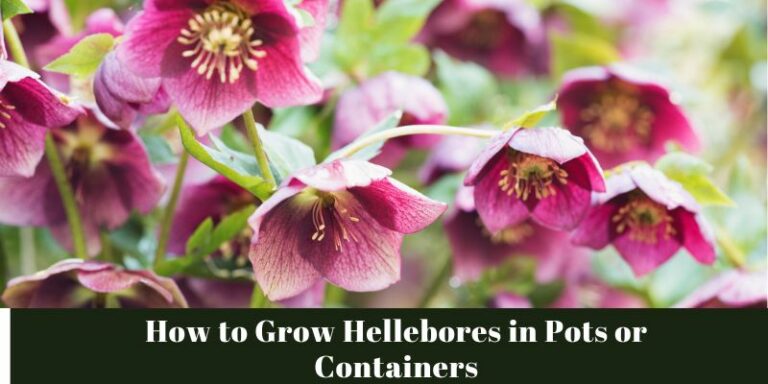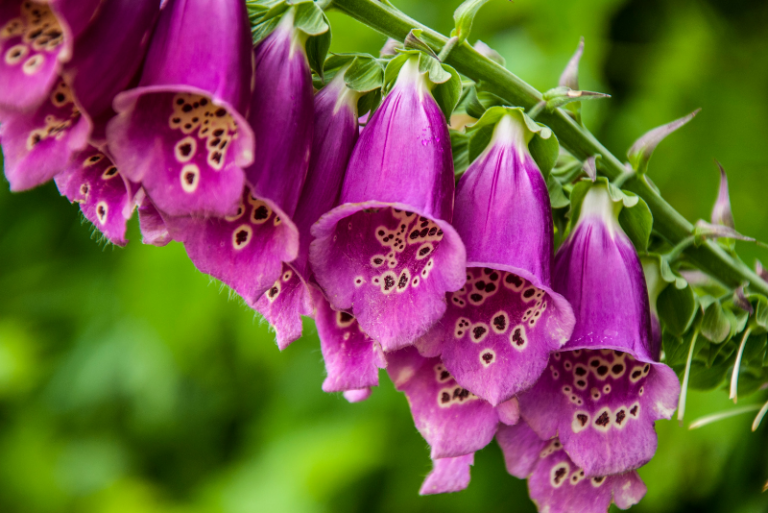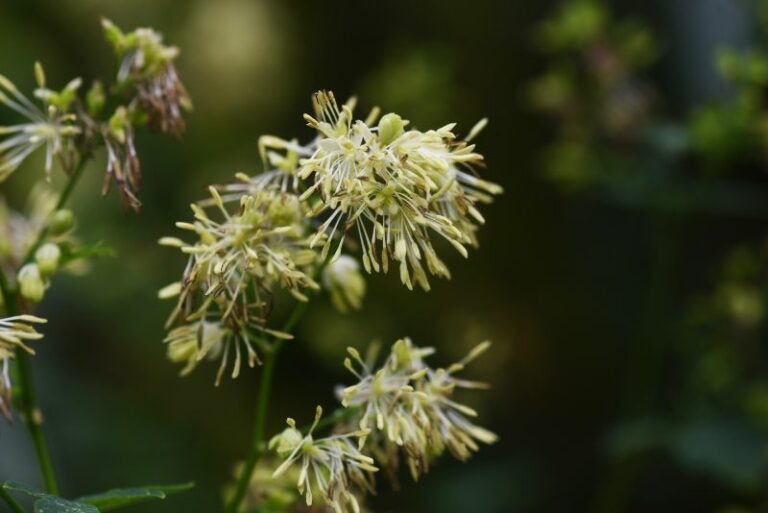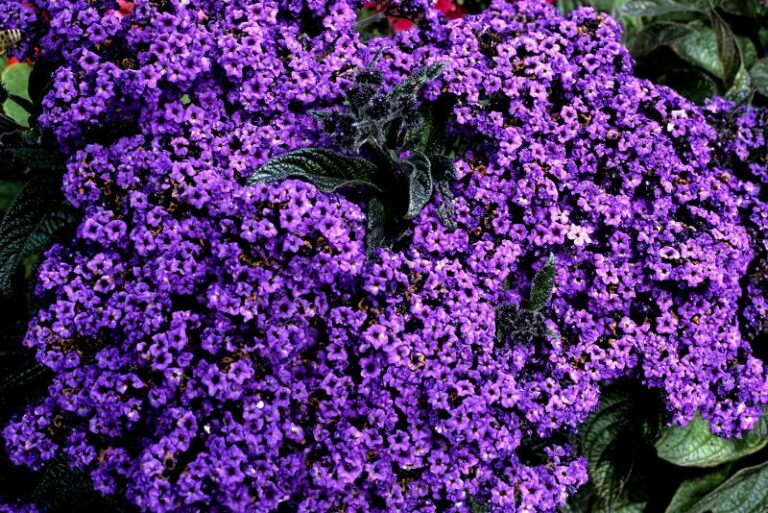West Indian Jasmine: How to Plant, Grow, and Care For Ixora
Welcome, fellow green thumbs and plant enthusiasts, to our definitive guide on how to plant, grow, and care for the mesmerizing beauty of Gloxinia flowering plants! Whether you’re a seasoned gardener looking to expand your repertoire or a novice who has just discovered the charm of these vibrant blooms, you’ve come to the right place.
In this comprehensive blog post, we will delve into the secrets of successfully cultivating and nurturing Gloxinias, allowing you to transform your garden into a resplendent oasis of color and elegance. So, grab your gardening gloves and get ready to embark on a botanical adventure filled with lush petals, delicate leaves, and a wealth of knowledge that will make your green heart flutter with delight.
Let us unravel the mysteries of Gloxinia together, and unleash the full potential of these breathtaking plants that never fail to captivate the eye and touch the soul.
Ixora Overview
| Features | Description |
|---|---|
| Common Name(s) | Jungle Geranium, Flame of the Woods, Jungle Flame |
| Scientific Name | Ixora coccinea |
| Family | Rubiaceae |
| Height | Up to 12 feet (3.6 meters) |
| Light | Full Sun to Partial Shade |
| Water | Regular watering but allow soil to dry between waterings |
| Soil | Well-draining, acidic soil with a pH between 4.5 and 6.5 |
| Fertilizer | Use a slow-release fertilizer high in acid such as those for rhododendrons or azaleas |
| Pests and Diseases | Can be affected by pests like aphids, scale, and mealybugs. Diseases can include fungal leaf spots and root rot if overwatered |
Please note that care can vary based on specific regional conditions. Always check with a local nursery or extension service for the most accurate information.
All About Ixora
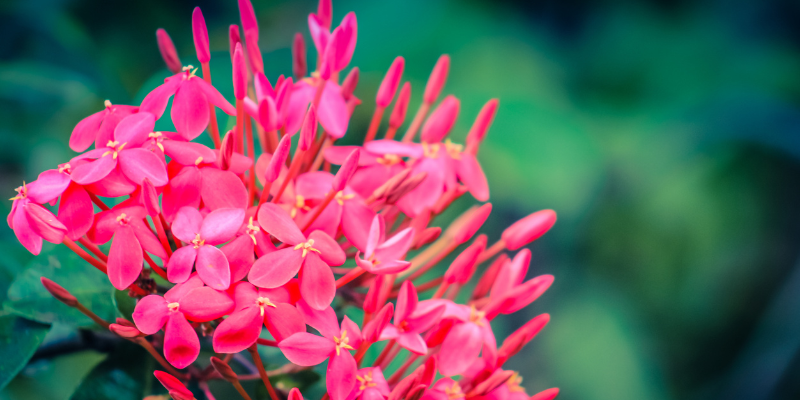
Ixora, commonly known as the Flame of the Woods or Jungle Flame, is a genus of flowering plants from the Rubiaceae family. Native to tropical and subtropical regions worldwide, it boasts around 562 species, the most popular ones being Ixora coccinea and Ixora chinensis.
Characterized by their vibrant flame-like clusters of flowers, Ixora plants cast a fiery spell with their shades of red, orange, yellow, and sometimes pink or white. These blooms are set against a backdrop of glossy, leathery leaves that lend lush greenery to your garden throughout the year.
Cultivating Ixora requires a warm, frost-free climate, and a well-draining, slightly acidic soil. They thrive in full sun to partial shade and prefer consistently moist, but not waterlogged soil. Overwatering and cold temperatures can lead to leaf drop, so it’s essential to maintain optimal conditions.
Ixora plants are often used in landscaping due to their striking appearance and ability to attract butterflies and hummingbirds. Their compact growth habit makes them an excellent choice for hedges or borders. Despite their tropical origins, they can also be grown indoors as houseplants, as long as they’re kept in sufficiently warm and sunlit conditions.
In terms of plant care, regular feeding with a balanced fertilizer during the growing season will help your Ixora thrive. Pruning after flowering will also keep the plant bushy and full. However, it’s important to note that Ixora can be prone to pests like scales, aphids, and mealybugs, so regular inspection and early pest intervention are crucial.
Ixora is not just a visually pleasing plant; it also has a rich history in traditional medicine. In many cultures, different parts of the plant have been used to treat a range of health conditions, from stomach complaints to skin disorders. Despite its medicinal uses, it’s essential to remember that Ixora can be toxic if ingested in large quantities, especially to pets.
Overall, Ixora is a charming plant that adds a touch of tropical appeal to any garden or indoor space. Its fiery blooms and lush leaves make it a captivating addition to any green space, whether you’re aiming to create a tropical paradise at home or just want to enjoy some vibrant color in your surroundings.
Exploring the Varieties of Ixora
There are myriad species of Ixora, each having their unique features. Here, we will delve into the history, appearance, scent, and similarities of the most popular Ixora varieties.
Ixora coccinea (Flame of the Woods)
Originating from South Asia, Ixora coccinea is the most common variety, often seen as hedges in subtropical gardens. Its nickname, “Flame of the Woods,” arises from its striking clusters of red or orange flowers that bloom almost all year round. The scent of these flowers is quite mild. Ixora coccinea’s other noteworthy features include its dark-green, glossy leaves and a bushy growth habit.
Ixora chinensis (Chinese Ixora)
As the name implies, Ixora chinensis originates from China and is widely adored for its large, bright pink flowers. These flowers emit a slight, sweet fragrance, adding to their appeal. Similar to Ixora coccinea, Ixora chinensis has glossy, dark-green leaves and a dense growth habit.
Ixora Javanica (Java Ixora)
Indigenous to Java, Ixora Javanica is loved for its fiery red flowers that bloom in clusters. The flowers have a faint, pleasing aroma, adding to their charm. The plant’s glossy leaves and bushy growth are consistent with other Ixora varieties.
Ixora pavetta (Torrid Star)
Ixora pavetta, native to India, is a true spectacle with its abundant clusters of white, star-shaped flowers that emit a strong fragrance, especially during the evening. This variety grows in a more tree-like form, setting it apart from its bushier siblings.
Despite the differences in origin, color, and fragrance, all Ixora varieties share common characteristics. They all have vibrant flowers that bloom in clusters, glossy green leaves, and prefer similar growing conditions. Their ability to attract butterflies and hummingbirds adds to their charm, making them a favorite among garden lovers. Whether you choose the fiery Ixora coccinea, the rosy Ixora chinensis, the exotic Ixora Javanica, or the elegant Ixora pavetta, you’re guaranteed to add a touch of tropical magic to your garden.
Ixora Care Procedures
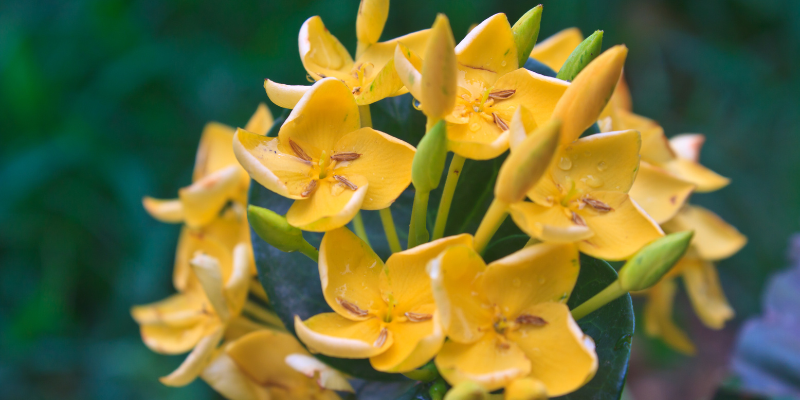
To ensure your Ixora thrives and produces stunning blooms, here are some essential care procedures to follow:
1. Light
Ixoras are sun-loving plants that thrive under full sunlight to partial shade. They appreciate at least six hours of direct sun daily, which encourages vibrant blooming. However, in particularly hot climates, they can benefit from afternoon shade to protect them from scorching. If you’re growing Ixoras indoors, place them near a south-facing window or under grow lights to ensure they receive enough light.
2. Temperature
Ixoras are tropical plants; they prefer warm temperatures and do not tolerate frost. They thrive best in temperatures between 60°F (15°C) and 85°F (29°C). If temperatures drop below 50°F (10°C), Ixoras may lose leaves and halt flowering. During winter, if you live in a cooler climate, it’s best to grow Ixoras in containers that can be brought indoors. Indoor Ixoras should be kept in a warm room, away from drafty windows or doors. Regular misting can help replicate the humid conditions of their native habitat.
3. Water
Ixoras prefer consistently moist soil but are susceptible to root rot if the soil becomes waterlogged. Therefore, it’s important to strike a balance when watering these plants. During the growing season (spring and summer), water them thoroughly whenever the top inch of the soil feels dry to the touch. However, reduce watering during the colder months (autumn and winter) as the plant’s growth slows down. When watering, avoid splashing water on the leaves as this can lead to fungal diseases. Using lukewarm water is also recommended to avoid shocking the plant’s roots with a sudden temperature change.
4. Humidity
Ixoras thrive in a high-humidity environment, similar to their native tropical habitats. If you’re growing Ixoras indoors or in a dry climate, maintaining adequate humidity can be a challenge. Regular misting of the plant can help increase humidity. Alternatively, you can place the pot on a pebble tray filled with water; as the water evaporates, it creates a humid microclimate around the plant. However, avoid drenching the leaves as this can lead to fungal issues. Installing a room humidifier is another effective way to keep indoor Ixoras happy.
Remember, the key to successful Ixora care lies in understanding and replicating its native tropical environment. By providing ample light, suitable temperature, enough water, and high humidity, you can enjoy the stunning, vibrant blooms of your Ixora plant year-round.
5. Soil
Ixoras prefer well-draining, fertile soil that can retain moisture without becoming waterlogged. A mix of sandy soil and peat moss with a small amount of perlite or vermiculite can work well, as this provides good aeration and proper moisture retention.
6. Soil pH
Ixoras prefer slightly acidic soil with a pH range of 5.0 to 6.0. If your soil is too alkaline, the plant may exhibit signs of nutrient deficiency, such as yellowing leaves. To lower the pH of your soil, you can add sulfur or use an acidic plant fertilizer. Conversely, to increase the pH, you can add lime. It’s crucial to test your soil’s pH before making any adjustments.
7. Preparing the Soil
Before planting Ixoras, prepare the soil by removing any weeds or stones and break up any large clods of soil. Once the area is clean, add organic matter like compost or well-rotted manure to improve soil fertility. If the soil is heavy clay or drains poorly, improve its structure by mixing in some sand and peat moss. Adjust the soil pH, if necessary, as per the above guidelines. After these amendments, water the soil thoroughly a day before you plan to plant your Ixora. This pre-planting preparation helps ensure your Ixora will have an ideal environment to grow and thrive.
Remember, providing the right soil conditions is a crucial aspect of Ixora care. With the appropriate soil type, pH, and careful preparation, your Ixora will reward you with a profusion of vibrant blooms.
8. Fertilizer
Fertilizing is an essential aspect of Ixora care that helps promote healthy growth and abundant flowering. Ixoras are heavy feeders that prefer a nutrient-rich environment. Therefore, regular feeding is necessary for the plants to perform at their best.
Type of Fertilizer
Ixoras benefit most from a balanced, slow-release fertilizer with a formula like 10-10-10 (Nitrogen-Phosphorus-Potassium). The balanced content ensures the plant receives essential nutrients needed for leaf development (Nitrogen), root growth (Phosphorus), and flower production (Potassium). Additionally, a fertilizer with added iron and other trace elements can help prevent nutrient deficiencies, especially in alkaline soils.
Fertilizer Application
Fertilize Ixora plants every two months during the growing season (spring and summer). Apply the fertilizer as per the manufacturer’s instructions, usually around the base of the plant. Avoid getting fertilizer on the foliage, as it can cause leaf burn. Remember to water the soil thoroughly after fertilizing to help the nutrients seep into the root zone. During the non-growing season (fall and winter), reduce the feeding to once every 3-4 months as the plant’s growth slows down.
Precautions
Be careful not to over-fertilize, as this can lead to salt buildup in the soil, resulting in leaf burn or even plant death. If you notice the leaves turning yellow or brown at the edges, this might indicate over-fertilization. In such a case, stop fertilizing and leach the soil with lots of water to rinse out the excess salts.
Remember, while Ixoras are heavy feeders, they appreciate a “less is more” approach when it comes to feeding. Proper fertilization, coupled with the right light, temperature, water, humidity, and soil conditions, is key to ensuring your Ixora plants thrive and produce spectacular blooms.
9. Repotting
Repotting Ixoras is another crucial aspect of their care. It not only provides the plant with fresh soil but also allows for better root development. Here is a comprehensive guide on how to repot your Ixora plant.
When to Repot
Ixoras typically need to be repotted every 2-3 years. The best time to repot is in the spring, just before the growing season starts. Signs that your Ixora needs repotting include stunted growth, roots emerging from the drainage holes, or the plant becoming top-heavy and tipping over.
Choosing a New Pot
Choose a pot that is about 2 inches larger in diameter than the previous one. Ensure the pot has adequate drainage holes to prevent waterlogging. A ceramic or terracotta pot is ideal as it allows for better air circulation around the roots, although plastic pots can also be used.
Repotting Process
To repot your Ixora, gently remove it from the current pot, taking care not to damage the roots. Brush off as much of the old soil as possible without hurting the plant. Inspect the roots for any signs of disease or pests, and trim off any dead or damaged roots. Place some fresh potting mix at the bottom of the new pot, position the plant so that the surface of the root ball is about 1 inch below the rim of the pot, and fill the rest of the pot with soil. Ensure the plant is planted at the same depth as it was in the previous pot.
9.4 Aftercare
After repotting, water the Ixora thoroughly and place it in a partially shaded location for a week to recover from the stress of repotting. After this recovery period, you can move the plant back to its original location.
Remember, repotting your Ixora is essential for its continued growth and health. Always make sure to use a suitable potting mix and pot, and follow the steps carefully to ensure a successful repotting process.
10. Propagation
Propagation is a rewarding aspect of Ixora care that allows you to multiply your plants. While division is a common method, as mentioned in the repotting section, Ixoras can also be propagated from cuttings and seeds.
Propagation by Cuttings
This is one of the most successful methods of propagating Ixoras. Here’s the step-by-step process:
- Select a healthy branch from the parent plant and make a cut about 4-6 inches from the end, ideally just below a leaf node.
- Remove the leaves from the lower half of the cutting.
- Dip the cut end into a rooting hormone powder. This is not essential but can improve the chances of successful root development.
- Prepare a small pot with a well-draining potting mix, such as a mixture of equal parts peat moss, perlite, and sand.
- Make a hole in the potting mix with a pencil and insert the cutting. Firm up the soil around the cutting.
- Place the pot in a shaded area and keep the soil moderately moist until new growth appears, indicating successful rooting.
Propagation by Seeds
While this method is more challenging and time-consuming, it can still be rewarding. Follow these steps:
- Collect seeds from mature Ixora plants. The seeds are typically found in the fruit that forms after flowering.
- Prepare a pot with a well-draining seed starting mix.
- Place the seeds on the surface of the soil and lightly cover them with the potting mix.
- Keep the soil consistently moist and place the pot in a warm, bright area.
- Once the seedlings have a couple of sets of true leaves, they can be transplanted into individual pots.
Precautions
Regardless of the propagation method chosen, it’s important to maintain the right environmental conditions. Both cuttings and seeds need warmth, bright but indirect light, and consistent moisture to successfully propagate. Also, using sterilized tools and pots can help prevent disease transmission.
Remember, propagation takes time and patience. Not every attempt may be successful, but don’t get disheartened. With proper care and conditions, you’ll likely end up with several new Ixoras to add to your garden or share with others.
11. Pruning
Pruning is a vital part of Ixora care that helps maintain the plant’s size and shape, encourages bushier growth, and can also improve the plant’s overall health by removing dead or diseased parts. Here is a detailed guide on how to prune your Ixora plant.
When to Prune
The best time to prune Ixoras is in the late winter or early spring, just before the new growth starts. However, light pruning can be done at any time of the year if necessary.
Tools Needed
For pruning Ixoras, use sharp pruning shears or a garden knife. Ensure that the tools are clean and sterilized to avoid transmitting diseases.
Pruning Process
Start the pruning process by removing any dead, diseased, or damaged branches. Make clean cuts at an angle, close to the base of the stem but not flush with the main trunk. Avoid tearing the bark. Next, prune any branches that are crossing or rubbing against each other as these can create entry points for pests or disease. Finally, prune the plant to maintain the desired size and shape. Make sure to trim back any overly long branches to keep the plant looking balanced and symmetrical.
After Pruning Care
After pruning, give the plant a thorough watering and apply a balanced fertilizer to support new growth. Keep an eye out for any signs of pest infestation or disease, especially in the weeks following pruning.
Remember, while Ixoras are relatively low-maintenance plants, regular pruning can significantly improve their health and appearance. Always prune with a purpose and don’t remove more than one-third of the plant’s total growth at one time.
Troubleshooting
Caring for your Ixora plant doesn’t come without challenges. However, knowing how to troubleshoot common problems can help you maintain its health and vibrancy. This section will cover some common growing problems, pests, and diseases that Ixora plants often encounter.
1. Growing Problems
a. Yellowing Leaves
If you notice your Ixora’s leaves turning yellow, it may be due to overwatering or poor drainage. Make sure you’re not keeping the soil waterlogged and that your pot has effective drainage holes.
b. Dropping Buds
Ixora plants may drop buds due to sudden changes in temperature or light. Ensure your plant is kept in a stable environment away from draughts or heating vents.
##Slow Growth
If your Ixora seems to be growing slowly, it may not be getting enough light or nutrients. Consider moving it to a sunnier spot and applying a balanced fertilizer.
2. Pests
a. Scale Insects
Scale insects are small pests that attach themselves to the leaves and stems of the Ixora, sucking sap and weakening the plant. A heavy infestation can cause leaf drop and reduced vigor. Treat them by applying a horticultural oil or insecticidal soap.
b. Spider Mites
These small mites may cause yellowing or stippling of leaves. Use a strong spray of water to knock off the mites and consider using a miticide if the infestation is severe.
3 Diseases
a. Root Rot
Overwatering or poor drainage can lead to root rot, a fungal disease that can cause the plant to wilt and the roots to turn soft and brown. To treat root rot, you may need to repot the Ixora in fresh, well-draining soil and ensure not to overwater.
b. Leaf Spot
Different fungi or bacteria can cause leaf spot diseases, which lead to brown or black spots on the leaves. Remove infected leaves and apply a suitable fungicide. Prevent leaf spot diseases by avoiding overhead watering and ensuring good air circulation around the plant.
Remember, while these issues can be frustrating, most can be prevented with proper care and promptly addressed when they do occur. Keep an eye on your Ixora for any signs of trouble, and you’ll be able to enjoy its beautiful blooms for years to come.
Frequently Asked Questions (FAQs)
Q1: How often should I water my Ixora plant?
A1: Ixora plants prefer evenly moist soil, but it’s important not to overwater. Water the plant when the top inch of soil feels dry to the touch. Overwatering or poor drainage can cause root rot.
Q2: Why are the leaves on my Ixora turning yellow?
A2: Yellowing leaves can be a sign of overwatering or poor drainage. Make sure the pot has effective drainage holes and that the soil isn’t waterlogged.
Q3: Why are the buds on my Ixora dropping?
A3: Bud drop can be caused by sudden changes in temperature or light. Try to keep your plant in a stable environment away from drafts or heating vents.
Q4: Why do my Ixora’s leaves have brown or black spots?
A4: Brown or black spots on the leaves can be a symptom of leaf spot disease, which is caused by various fungi or bacteria. To prevent this, avoid overhead watering and ensure good air circulation around the plant.
Q5: How do I treat a pest infestation on my Ixora plant?
A5: Treatment varies depending on the type of pest. For scale insects, apply horticultural oil or insecticidal soap. For spider mites, a strong spray of water can displace them. If infestation is severe, consider using a miticide.
Q6: How often should I prune my Ixora?
A6: Pruning is usually done once a year, in the late winter or early spring, just before new growth starts. However, light pruning can be done at any time if necessary.
Q7: Can I grow Ixora indoors?
A7: Yes, you can grow Ixora indoors as long as you can provide it with plenty of bright, indirect light. It also needs high humidity, so consider placing it on a tray of pebbles filled with water, or mist it regularly.
Remember, caring for Ixora requires patience and attention. With the right care, you can enjoy the rewarding sight of its vibrant and beautiful blooms.

